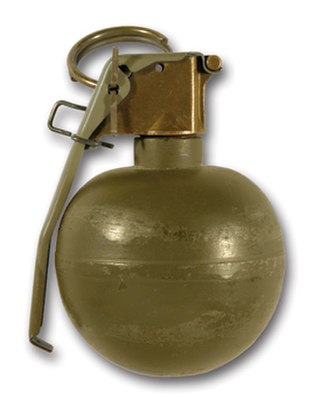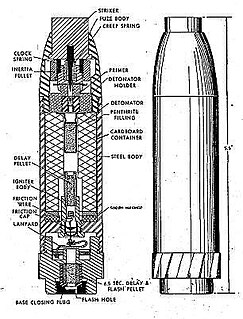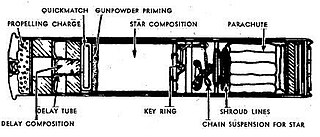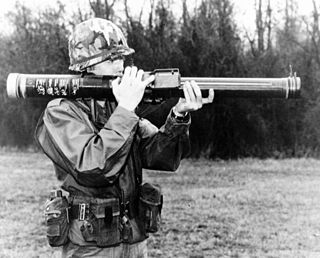
An armor-piercing shell, AP for short, is a type of ammunition designed to penetrate armor. From the 1860s to 1950s, a major application of armor-piercing projectiles was to defeat the thick armor carried on many warships. From the 1920s onwards, armor-piercing weapons were required for anti-tank missions. AP rounds smaller than 20 mm are typically known as "armor-piercing ammunition", and are intended for lightly-armored targets such as body armor, bulletproof glass and light armored vehicles. The classic AP shell is now seldom used in naval warfare, as modern warships have little or no armor protection, and newer technologies have displaced the classic AP design in the anti-tank role.

A high-explosive anti-tank (HEAT) warhead is a type of shaped charge explosive that uses the Munroe effect to penetrate thick tank armor. The warhead functions by having the explosive charge collapse a metal liner inside the warhead into a high-velocity superplastic jet. This superplastic jet is capable of penetrating armor steel to a depth of seven or more times the diameter of the charge but is usually used to immobilize or destroy tanks. Due to the way they work, they do not have to be fired as fast as an armor piercing shell, allowing less recoil. Contrary to a widespread misconception, the jet does not melt its way through armor, as its effect is purely kinetic in nature. The HEAT warhead has become less effective against tanks and other armored vehicles due to the use of composite armor, explosive-reactive armor, and active protection systems which destroy the HEAT warhead before it hits the tank. Even though HEAT rounds are less effective against the heavy armour of 2010-era main battle tanks, HEAT warheads remain a threat against less-armoured parts of a main battle tank and against lighter armoured vehicles or unarmoured vehicles and helicopters.

A shell is a payload-carrying projectile that, as opposed to shot, contains an explosive or other filling, though modern usage sometimes includes large solid projectiles properly termed shot. Solid shot may contain a pyrotechnic compound if a tracer or spotting charge is used. Originally, it was called a "bombshell", but "shell" has come to be unambiguous in a military context.
The Yasin anti-tank rocket launcher is a weapon developed by Hamas' Ezzedeen-al-Qassam brigades named after the group's spiritual leader, Sheik Ahmed Yasin, killed by the Israeli Defense Forces (IDF) on March 22, 2004.

RKG-3 is a series of Russian anti-tank hand grenades. It superseded the RPG-43, RPG-40 and RPG-6 series of grenades. It entered service in 1950, but was still used by Iraqi insurgents in the mid-2000s, against vehicles of the US forces.

A grenade is a small explosive weapon typically thrown by hand, but can also refer to projectiles shot out of grenade launchers. Generally, a grenade consists of an explosive charge, a detonating mechanism, and firing pin inside the grenade to trigger the detonating mechanism. Once the soldier throws the grenade, the safety lever releases, the striker throws the safety lever away from the grenade body as it rotates to detonate the primer. The primer explodes and ignites the fuze. The fuze burns down to the detonator, which explodes the main charge.

The Stielgranate 41 was a German shaped charge, fin-stabilized shell, used with the 3.7 cm Pak 36 anti-tank gun to give it better anti-tank performance.

The Type 3 "Anti-Tank" Hand Grenade is a Japanese grenade produced from 1943 to 1945 during World War II. It was designed to destroy the Allies tanks. There are three variants (sub-types) of the weapon: Ko, Otsu, and Hei.

The Stielgranate 42 was a German fin-stabilized demolition charge, used with the 15 cm SIG 33 heavy infantry gun and armored vehicles armed with the SIG 33 during World War II. The primary purpose of the Stielgranate 42 was the demolition of concrete fortifications and for the clearing of minefields and barbed wire. Unlike the Stielgranate 41 it was not a shaped charge anti-tank weapon. In an emergency, the Stielgranate 42 could be used in an anti-tank role to great effect but due to its short range and poor accuracy the gun crew would be dangerously exposed to enemy fire.
During the Second World War, the Luftwaffe developed a series of unguided rocket-propelled armor-piercing bombs. The three main types were the PC 500 RS, PC 1000 RS, and PC 1800 RS. The PC in the name stands for Panzersprengbombe Cylindrisch, the number equals the approximate weight of the bomb in kilograms, and RS indicates it is rocket propelled. These bombs were intended to be used against armored ships or similar targets. The purpose of the rocket was to increase the terminal velocity of the bomb and aid penetration.

The Propaganda-Gewehrgranate was a non-lethal rifle grenade designed to deliver propaganda leaflets that was developed by Germany and used by the Wehrmacht during World War II.

The Gewehr-Sprenggranate was a high-explosive rifle grenade that was developed by Germany and used by the Wehrmacht during World War II.

The Gross Panzergranate 46 & 61 were shaped charge rifle grenades that were developed by Germany and used by the Waffen-SS during World War II.

The Gewehr-Granatpatrone 40 or GGP/40 for short was a shaped charge rifle grenade used by German forces during the Second World War. It was originally developed for Luftwaffe Fallschirmjäger units to provide them with a light and portable anti-tank weapon.

The Panzerwurfkörper 42 was an HEAT grenade that was developed by Germany and used by the Wehrmacht during World War II. The Panzerwurfkörper 42 was designed to be fired from a Leuchtpistole or flare gun in English.

The Fallschirm Leuchtpatrone or "parachute light cartridge" in English was a non-lethal star shell that was developed by Germany and used by the Wehrmacht during World War II. The Fallschirm Leuchtpatrone was designed to be fired from a Kampfpistole flare gun.

The Nebelpatrone or "fog cartridge" in English was a non-lethal smoke grenade that was developed by Germany and used by the Wehrmacht during World War II. The Nebelpatrone was designed to be fired from a Kampfpistole flare gun.

The Sprengpatrone or "explosive cartridge" in English was a rifle grenade that was developed by Germany and used by the Wehrmacht during World War II. The Sprengpatrone was designed to be fired from a Kampfpistole flare gun.























